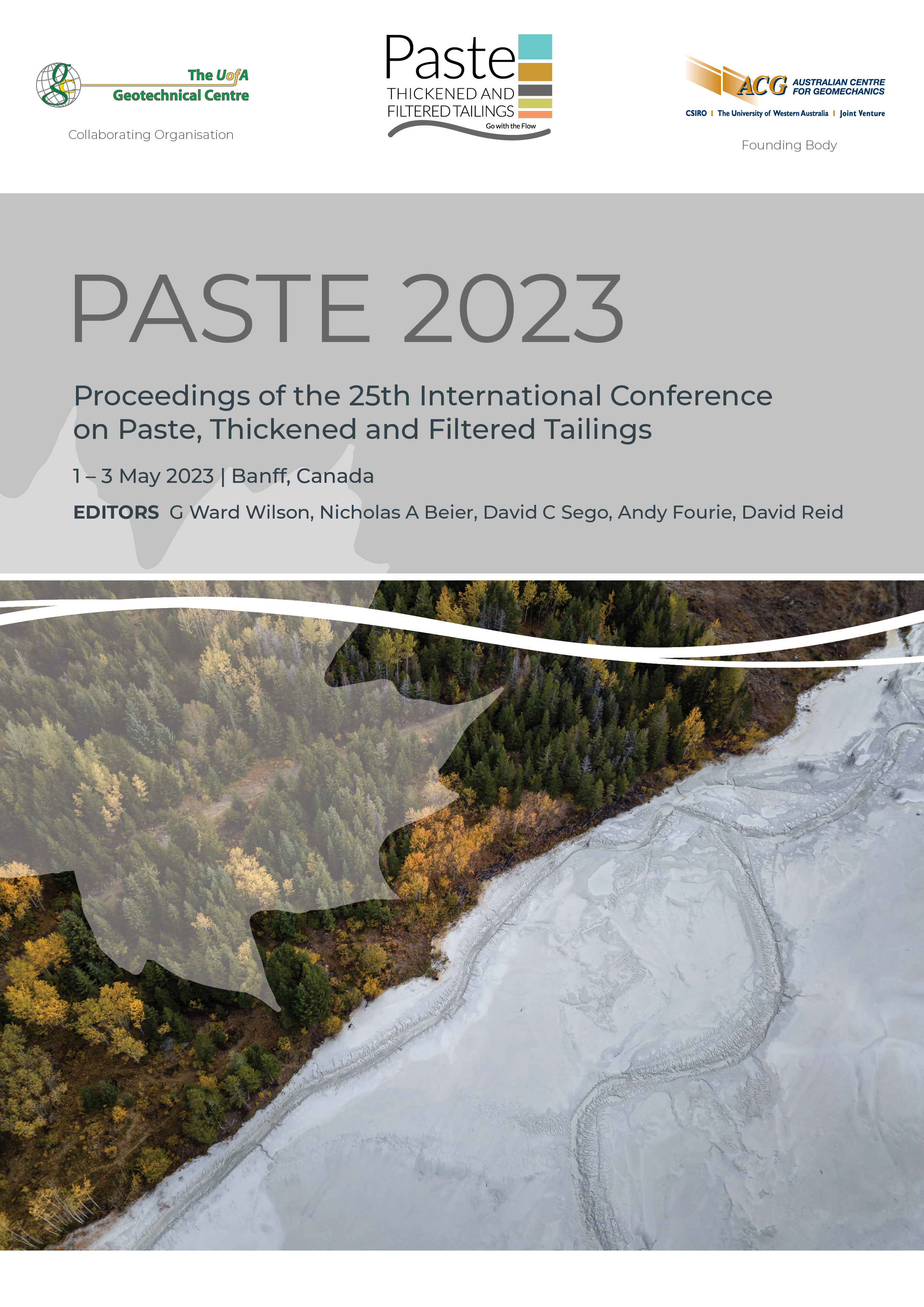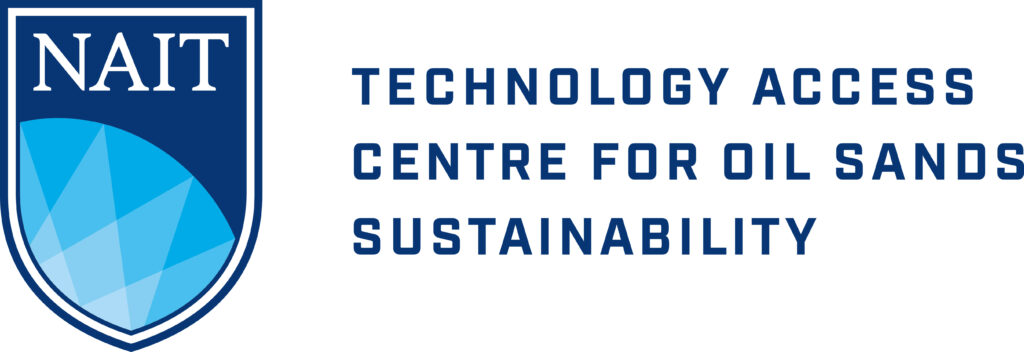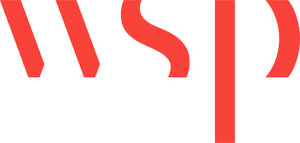A cost-effective tailings solution to rheology issues while meeting the environmental constraints using inexpensive additives

|
Authors: Leong, YK; Bensley, SJ; Drewett, J; Burkett S |
DOI https://doi.org/10.36487/ACG_repo/2355_43
Cite As:
Leong, YK, Bensley, SJ, Drewett, J & Burkett S 2023, 'A cost-effective tailings solution to rheology issues while meeting the environmental constraints using inexpensive additives', in GW Wilson, NA Beier, DC Sego, AB Fourie & D Reid (eds), Paste 2023: Proceedings of the 25th International Conference on Paste, Thickened and Filtered Tailings, Australian Centre for Geomechanics, Perth, pp. 580-587, https://doi.org/10.36487/ACG_repo/2355_43
Abstract:
A significant quantity of tailings is produced in the wet beneficiation of iron ore. These tailings are flocculated and thickened in a thickener before being pumped to a tailings storage facility TSF, i.e., a pond, which can be several km away. Occasionally, the thickened tailings acquired a higher yield stress than can be pumped. This material then becomes a bottleneck reducing the plant output. This study demonstrates how to reduce these problematic tailings’ yield stress or viscosity with a cheap additive. NaOH costing ~ US 400 per tonne resulted in a 50-60% reduction in the yield stress at pH 10 and ~ 90% reduction in the viscosity at 100s-1. The legislated environmental constraints are i) the pH of the disposed of tailings must be less than 10 and ii) any chemical leachate of heavy metal ions must be less than stock drinking water guidelines or water table water. Leaching results showed this was the case for all leachate chemicals evaluated up to pH 11.2. Some leachate chemicals evaluated were As, B, Cr, Cu, Mo, Pb, Se, Th, Ti, U and V. However, not all tailings (from different mines) respond to NaOH treatment.
Keywords: rheology control, composite additives, leachate, heavy metal, dry stacking, filtration
References:
Das, SK, Kumar, S & Ramachandrarao, P 2000, ‘Exploitation of iron ore tailing for the development of ceramic tiles’, Waste Management, vol. 20, pp. 725-729,
Filippov, LO, Severov VV & Filippova, IV 2014, ‘An overview of the beneficiation of iron ores via reverse cationic flotation’, International Journal of Mineral Processing, vol. 127, pp. 62-69,
Fontes, WC, Franco de Carvalho, JM, Andrade, LCR, Segadaes, AM & Peixoto, RAF 2019, ‘Assessment of the use potential of iron ore tailings in the manufacture of ceramic tiles: From tailings-dams to “brown porcelain”’, Construction and Building Materials, vol. 206, pp. 111-121,
Gomes, RB, De Tomi, G & Assis, PS 2016, ‘Iron ore tailings dry stacking in Pau Branco mine, Brazil’, Journal of Materials Research and Technology, vol. 5, no. 4, pp.339-344,
Kumar, R & Mandre, NR 2016, ‘Characterization and beneficiation of iron ore tailings by selective flocculation’, Transactions of the Indian Institute of Metals, vol. 69, pp.1459–1466,
Leong, YK 2018, Method of Rheology Control, Australia, Innovation Patent No: 2018100304, Australia Government, IP Australia
Leong, YK 2020, Controlling Rheology of Iron Ore Tailings Slurries, Australia, Innovation Patent No: 2020103937, Australia Government, IP Australia.
Leong, YK 2021, ‘Controlling the rheology of iron ore slurries and tailings with surface chemistry for enhanced beneficiation performance and output, reduced pumping cost and safer tailings storage in dam’, Minerals Engineering, vol. 166, article no. 106874,
Leong, YK, Drewitt, J & Bensley, S 2019, ‘Reducing the viscosity of concentrated iron ore slurries with composite additives for quality upgrade, reduced power, safer tailings storage and smaller environmental footprint’, in Iron Ore 2019: Optimising Value, The Australasian Institute of Mining and Metallurgy, Perth, pp. 738-743,
Li, C, Sun, H, Yi, Z & Li, L 2010, ‘Innovative methodology for comprehensive utilization of iron ore tailings: Part 2: The residues after iron recovery from iron ore tailings to prepare cementitious material’, Journal of Hazardous Materials, vol. 174, nos. 1-3, pp. 78-83,
Mahiuddin, S, Bondyopadhway, S & Baruah, N 1989, ‘A study on the beneficiation of Indian iron-ore fines and slime using chemical additives’, International Journal of Minerals Processing, vol. 26, nos. 3-4, pp. 285-296,
Mamghaderi, H, Aghababaei, S, Gharabaghi, M, Noaparast, M, Albijanic, B & Rezaei, A 2021, ‘Investigation on the effects of chemical pretreatment on the iron ore tailing dewatering, Colloids and Surfaces A: Physiochemical and Engineering Aspects, vol. 625, article no. 126855,
SRK Consulting, 2018, Hope Down 4: Geochemical Characterization and Alkaline Leaching Potential, RTS153 report to Rio Tinto, SRK Consulting (Australasia) Pty Ltd, 52 pages.
Williams, DJ 2021, ‘Lessons from tailings dam failures—where to go from here?’, Minerals, vol. 11, no. 8, p. 853,
Xiong, C, Li, W, Jiang, L, Wang, W & Guo, Q 2017, ‘Use of grounded iron ore tailings (GIOTs) and BaCO3 to improve sulfate resistance of pastes’, Construction and Building Materials, vol. 150, pp. 66-76,
Zhao, J, Ni, K, Su, Y & Shi, Y 2021, ‘An evaluation of iron ore tailings characteristics and iron ore tailings concrete properties’, Construction and Building Materials, vol. 286, article no. 122968,
© Copyright 2025, Australian Centre for Geomechanics (ACG), The University of Western Australia. All rights reserved.
View copyright/legal information
Please direct any queries or error reports to repository-acg@uwa.edu.au
View copyright/legal information
Please direct any queries or error reports to repository-acg@uwa.edu.au



